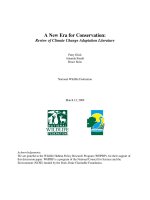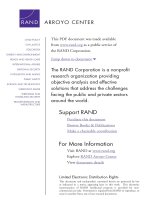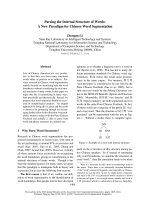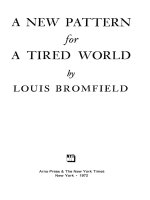Team Risk Management: A New Model for Customer- Supplier Relationships doc
Bạn đang xem bản rút gọn của tài liệu. Xem và tải ngay bản đầy đủ của tài liệu tại đây (167.44 KB, 30 trang )
Special Report
CMU/SEI-94-SR-5
Team Risk Management:
A New Model for Customer-
Supplier Relationships
Ronald P. Higuera
Audrey J. Dorofee
Julie A. Walker
Ray C. Williams
July 1994
Software Engineering Institute
Carnegie Mellon University
Pittsburgh, Pennsylvania 15213
Unlimited distribution subject to the copyright.
Technical Report
CMU/SEI-94-SR-005
July 1994
Team Risk Management: A New Model for
Customer-Supplier Relationships
Ronald P. Higuera
Audrey J. Dorofee
Julia A. Walker
Ray C. Williams
Team Risk Management Project
This report was prepared for the
SEI Joint Program Office
HQ ESC/AXS
5 Eglin Street
Hanscom AFB, MA 01731-2116
The ideas and findings in this report should not be construed as an official DoD position. It is published in the
interest of scientific and technical information exchange.
FOR THE COMMANDER
(signature on file)
Thomas R. Miller, Lt Col, USAF
SEI Joint Program Office
This work is sponsored by the U.S. Department of Defense.
Copyright © 1994 by Carnegie Mellon University.
Permission to reproduce this document and to prepare derivative works from this document for internal use is
granted, provided the copyright and “No Warranty” statements are included with all reproductions and derivative
works.
Requests for permission to reproduce this document or to prepare derivative works of this document for external
and commercial use should be addressed to the SEI Licensing Agent.
NO WARRANTY
THIS CARNEGIE MELLON UNIVERSITY AND SOFTWARE ENGINEERING INSTITUTE MATERIAL
IS FURNISHED ON AN “AS-IS” BASIS. CARNEGIE MELLON UNIVERSITY MAKES NO WARRAN-
TIES OF ANY KIND, EITHER EXPRESSED OR IMPLIED, AS TO ANY MATTER INCLUDING, BUT NOT
LIMITED TO, WARRANTY OF FITNESS FOR PURPOSE OR MERCHANTIBILITY, EXCLUSIVITY, OR
RESULTS OBTAINED FROM USE OF THE MATERIAL. CARNEGIE MELLON UNIVERSITY DOES
NOT MAKE ANY WARRANTY OF ANY KIND WITH RESPECT TO FREEDOM FROM PATENT,
TRADEMARK, OR COPYRIGHT INFRINGEMENT.
This work was created in the performance of Federal Government Contract Number F19628-95-C-0003 with
Carnegie Mellon University for the operation of the Software Engineering Institute, a federally funded research
and development center. The Government of the United States has a royalty-free government-purpose license to
use, duplicate, or disclose the work, in whole or in part and in any manner, and to have or permit others to do so,
for government purposes pursuant to the copyright license under the clause at 52.227-7013.
This document is available through Research Access, Inc., 800 Vinial Street, Pittsburgh, PA 15212.
Phone: 1-800-685-6510. FAX: (412) 321-2994. RAI also maintains a World Wide Web home page. The URL is
Copies of this document are available through the National Technical Information Service (NTIS). For informa-
tion on ordering, please contact NTIS directly: National Technical Information Service, U.S. Department of
Commerce, Springfield, VA 22161. Phone: (703) 487-4600.
This document is also available through the Defense Technical Information Center (DTIC). DTIC provides access
to and transfer of scientific and technical information for DoD personnel, DoD contractors and potential contrac-
tors, and other U.S. Government agency personnel and their contractors. To obtain a copy, please contact DTIC
directly: Defense Technical Information Center / 8725 John J. Kingman Road / Suite 0944 / Ft. Belvoir, VA
22060-6218. Phone: (703) 767-8222 or 1-800 225-3842.]
Use of any trademarks in this report is not intended in any way to infringe on the rights of the trademark holder.
1
Overview
Introduction The Software Engineering Institute (SEI), a federally funded research and develop-
ment center and part of Carnegie Mellon University in Pittsburgh, Pennsylvania,
has been formally studying and developing risk management concepts since Janu-
ary 1990 as an efficient means to improve the success of programs developing soft-
ware-intensive systems.
Team Risk Management is a new paradigm for managing programs or projects by
developing a shared product vision, focused on results, and using the principles and
tools of risk management to cooperatively manage risks and opportunities.
Purpose This report will familiarize you with the concept of Team Risk Management by pro-
viding a description of the overall process that engages both the customer and sup-
plier in a cooperative framework using explicit methods to manage project risks.
Objectives After reading this report you should be able to
• understand the Team Risk Management concept
• differentiate Team Risk Management from risk management
• answer the question, “Is it useful to me?”
• know what is required to initiate Team Risk Management
Benefits Your organization or project will derive the following benefits from Team Risk
Management.
• Improve customer-supplier and internal communication.
• Use a concise approach and systematic discipline that carries over to other
activities.
• Enable your program or project to face issues that before tended to be too
abstract to handle.
• Improve design and fundamentally alter development decisions.
• Provide more focus to program or project activity.
• Increase product development predictability – reduce surprises.
2
In This
Report
This report contains the following topics:
Topic Page
Risk Terms and Definitions 3
Risk Management 6
SEI Risk Management Paradigm 8
How Risk Management Fits with Project Management 9
Team Risk Management Principles 11
Team Risk Management Functions 12
Scenario Comparing Team Risk Management to Risk Management 17
Advantages of Team Risk Management 19
Answers to Frequently Asked Questions 21
References 23
3
Risk Terms and Definitions
Background There are a number of definitions and uses for the term risk, but no universally ac-
cepted definition.
What all definitions have in common is agreement that risk has two characteristics
[Kirkpatrick 92, p.7]:
• uncertainty - an event may or may not happen
• loss - an event has unwanted consequences or losses
Rowe
Definition
Risk is the potential for realization of unwanted negative consequences of an event
[Rowe 88, p. 24].
Lowrance
Definition
Risk is the measure of the probability and severity of adverse effects [Lowrance 76,
p. 94].
Webster’s
Definition
Risk is the possibility of suffering loss, injury, disadvantage, or destruction [Web-
ster’s Dictionary 81, p. 1961].
SEI Definition The SEI uses the Webster’s definition of risk.
Risk is the possibility of suffering loss.
In a development program, the loss could be in the form of diminished quality of
the end product, increased costs, delayed completion, or failure.
SEI Statement
of Risk
For a risk to be understandable, it must be expressed clearly. Such a statement must
include
• a description of the current conditions that may lead to the loss
• a description of the loss
4
Example of
Risk
Company XYZ has just introduced object-oriented technology into its organization.
They see this new technology as having considerable competitive advantage in the
future because of its potential for asset reuse in their major product lines. Although
many people within the organization are familiar with the technology, it has not
been part of their development process, and their people have very little experience
and training in the technology’s application.
The risk is: Given the lack of experience and training, there is a possibility that as-
set reuse will not be realized before losing market share.
Non-Example
of Risk
Company ABC is developing a flight control system. During system integration
testing the flight control system becomes unstable because processing of the control
function is not quick enough during a specific maneuver sequence.
This is not a risk since the event is a certainty – it is a problem.
Team A team is a small number of people with complementary skills who are committed
to a common purpose, set of performance goals, and approach for which they hold
themselves mutually accountable [Katzenbach 93, p. 112].
Example of
Team
An integrated product team includes representatives from developer, marketers,
customers, and users all working toward and accountable for the successful devel-
opment of a product on time and within budget.
Customer The term customer refers to the organization acquiring systems (typically designat-
ed as programs or projects) and is responsible for
• defining the requirements
• obtaining funding
• selecting the supplier/contractor
• negotiating the contract
• accepting the product [Kirkpatrick 92]
In this report, the term government is used as a specific example of a customer.
Note: Project and program are considered synonymous terms in this report.
5
Supplier The term supplier refers to the organization developing and producing the system
and is responsible for implementing the requirements under the terms of the con-
tract, which include cost and schedule [Kirkpatrick 92].
In this document, the term contractor is used as a specific example of a supplier.
6
Risk Management
Background The term risk management is applied in a number of diverse disciplines. People in
the fields of statistics, economics, psychology, social sciences, biology, engineer-
ing, toxicology, systems analysis, operations research, and decision theory, to name
a few, have been addressing the field of risk management [Kirkpatrick 92, p. 8].
Kloman summarized the meaning of risk management in the context of a number
of different disciplines in an article for Risk Analysis:
What is risk management? To many social analysts, politicians, and
academics it is the management of environmental and nuclear risks,
those technology-generated macro-risks that appear to threaten our
existence. To bankers and financial officers it is the sophisticated
use of such techniques as currency hedging and interest rate swaps.
To insurance buyers and sellers it is coordination of insurable risks
and the reduction of insurance costs. To hospital administrators it
may mean ‘quality assurance.’ To safety professionals it is reducing
accidents and injuries [Kloman 90, p. 20].
Kloman
Paraphrase of
Rowe
Risk management is a discipline for living with the possibility that future events
may cause adverse effects [Kloman 90, p. 203].
SEI Definition Risk management sets forth a discipline and environment of proactive decisions
and actions to
1. assess continuously what can go wrong (risks).
2. determine what risks are important to deal with.
3. implement strategies to deal with those risk.
Note: The SEI definition emphasizes the continuous aspect of risk management.
Example When using true risk management, risks are assessed continuously and used for de-
cision making in all phases of a project. Risks are carried forward and dealt with
until they are resolved, or until they turn into problems and are handled as such.
Non-Example In some programs, risks are assessed only once during initial project planning. Ma-
jor risks are identified and mitigated, but risks are never explicitly reviewed again.
This is not an example of risk management because risks would not be continuously
assessed and new risks continuously identified.
7
Principles of
Risk
Management
These five principles provide a framework to accomplish effective risk manage-
ment.
Principle Effective risk management requires
Global perspective • Viewing software development within
the context of the larger systems-level
definition, design, and development.
• Recognizing both the potential value of
opportunity and the potential impact of
adverse effects.
Forward-looking view • Thinking toward tomorrow, identifying
uncertainties, anticipating potential
outcomes.
• Managing project resources and
activities while anticipating
uncertainties.
Open communication • Encouraging free-flowing information at
and between all project levels.
• Enabling formal, informal, and
impromptu communication.
• Using processes that value the individual
voice (bringing unique knowledge and
insight to identifying and managing
risk).
Integrated management • Making risk management an integral and
vital part of project management.
• Adapting risk management methods and
tools to a project’s infrastructure and
culture.
Continuous process • Sustaining constant vigilance.
• Identifying and managing risks routinely
throughout all phases of the project’s life
cycle.
8
SEI Risk Management Paradigm
Risk
Management
Paradigm
The SEI Risk Management Paradigm is depicted below [Van Scoy 92, p. 9]. The
paradigm illustrates a set of functions that are identified as continuous activities
throughout the life cycle of a project.
Functions of
Risk
Management
The functions of risk management are described below [SEI 92, Higuera 93]. Each
risk nominally goes through these functions sequentially but the activity occurs
continuously, concurrently, and iteratively throughout the project life cycle (e.g.,
planning for one risk may identify another).
Identify
Analyze
Plan
Track
Control
Communicate
Function Description
Identify Search for and locate risks before they become problems.
Analyze Process risk data into decision-making information.
Determine the values of impact, likelihood, and time-
frame.
Plan Translate risk information into decisions and actions
(both present and future) and implement those actions.
Track Monitor risk indicators and mitigation actions.
Control Correct for deviations from the planned risk actions.
Communicate Provide information and feedback internal and external to
the project on the risk activities, current risks, and
emerging risks.
Note: Communication happens throughout all the
functions of risk management.
9
How Risk Management Fits with Project
Management
Introduction Risk management integrates readily with the functions of project management, and
adds new power and scope to those functions.
Project
Management
Project management may be thought of as a set of people-oriented, integrated activ-
ities as shown below [Kezbom 89, p. 3-6].
Project
Management
Functions
The functions of project management are described below [Kezbom 89, p. 4].
Directing
Controlling
Project Management
Project
Manager
Organizing
Planning
Function Description
Planning Define desired results, strategy, course of action,
and checkpoints.
Organizing Establish structure, roles and responsibilities, and
allocate resources.
Directing Communicate, delegate, and coordinate activities.
Controlling Provide measurement, feedback, evaluation, and
adjustment.
10
What Risk
Management
Adds to
Project
Management
Risk management looks ahead in the project and adds a structured approach for the
identification and analysis of risks to begin planning. Risk planning adds the proac-
tive perspective of alternatives and contingencies to mitigate risk, whereas the
“Track” and “Control” functions of the risk management paradigm merges with the
controlling function in project management.
In addition, the five principles of risk management (global perspective, forward-
looking view, open communication, integrated management, continuous process)
strengthen the proactive and systematic nature of effective project management.
Integrated
Project
Management
Concept
The combination of these two concepts is shown in the diagram below.
Directing
Controlling
Integrated Project Management
Identify
Analyze
Plan
Track
Control
Communicate
Organizing
Planning
11
Team Risk Management Principles
Team Activities Team Risk Management extends risk management with team-oriented activities in-
volving the customer and supplier (e.g., government and contractor) where customer
and supplier apply methods together.
Principles of
Team Risk
Management
The first two principles below added to the five principles of risk management con-
stitute the principles of Team Risk Management. Open communications are further
enhanced when customer and supplier use consensus-based processes that also value
the individual voice.
Customer Supplier
Team
Activities
Identify
Analyze
Plan
Track
Control
Communicate
Identify
Analyze
Plan
Track
Control
Communicate
Principle Effective Team Risk Management
requires:
Shared product vision • Sharing a product vision based upon
common purpose, shared ownership, and
collective commitment.
• Focusing on results.
Teamwork • Working cooperatively to achieve a
common goal.
• Pooling talent, skills, and knowledge.
Global perspective • Viewing within the systems context.
Forward-looking view • Anticipating uncertainties.
Open communication • Enabling communication.
• Using consensus-based processes
between customer and supplier that
value the individual voice.
Integrated management • Making risk management integral.
Continuous process • Managing risks routinely.
12
Team Risk Management Functions
Introduction Team Risk Management establishes an environment built on a set of processes,
methods, and tools that enable the customer and supplier to work together coopera-
tively, continuously managing risks throughout the life cycle of a software-depen-
dent development program. It is built on a foundation of the principles of risk man-
agement and the philosophy of cooperative teams.
Team Risk
Management
Defined
Team Risk Management is a paradigm for managing programs or projects by devel-
oping a shared product vision, focused on results, and using the principles and tools
of risk management to cooperatively manage risks and opportunities.
Adding Team
To Risk
Management
Team Risk Management implements the functions of risk management that are il-
lustrated in the SEI Risk Paradigm by adding the principles of shared product vision
and teamwork to make up the functions of Team Risk Management.
Team Risk Management adds two new functions, Initiate and Team, to recognize
both the required cultural paradigm shift and the emphasis on teamwork.
Identify
Analyze
Plan
Track
Control
Communicate
Risk Paradigm
Team Risk Management
Functions
• Initiate
• Team*
• Identify
• Analyze
• Plan
• Track
• Control
Shared Vision
Teamwork
Team Risk
*Note:Team is used as an action verb.
Management
Principles
13
Team Risk
Management
Model
The Team Risk Management model is shown below. Each function has a set of ac-
tivities that are backed by processes, methods, and tools that encourage and enhance
communication and teamwork. Two additional functions, Initiate and Team, de-
scribed below complete the model.
INITIATE TEAM IDENTIFY
ANALYZE
PLAN
TRACK
CONTROL
COMMUNICATE
CUSTOMER
SUPPLIER
14
Team Risk
Management
Functions
The table below describes how Team Risk Management implements the risk man-
agement functions. Communication is an integral part of all these activities. Howev-
er, explicit formal activities provide excellent communication opportunities for both
customer and supplier.
Function Description
Initiate Recognize the need and commit to create the team culture.
Either customer or supplier may initiate team activity, but
both must commit to sustain the teams.
Team Formalize the customer and supplier team and merge the
viewpoints to form a shared product vision. Systematic
methods periodically and jointly applied establish a shared
understanding of the project risks and their relative
importance. Establish joint information base of risks,
priorities, metrics, and action plans.
Example methods:
• team building
Identify Search for and locate risks before they become problems.
Identify risks and set project priorities to arrive at a joint
understanding of what is important.
Identify new risks and changes.
Example methods:
• reviewing lists of existing risks and known or anticipated
changes
• structured interviews applied to teams periodically, such
as at major milestones
INITIA TE TEAM IDENTIFY
ANAL YZE
PLAN
TRACK
CONTROL
COMMUNICATE
CUSTOMER
SUPPLIE
R
INITIA TE TEAM IDENTIFY
ANAL YZE
PLAN
TRACK
CONTROL
COMMUNICATE
CUST
OMER
SUPPLIE
INITIA TE TEAM IDENTIFY
ANAL YZE
PLAN
TRACK
CONTROL
COMMUNICATE
CUSTOMER
SUPPLIE
R
15
Team Risk
Management
Functions,
continued
Function Description
Analyze Process risk data into decision-making information. Risk
analysis is performed to determine what is important to the
project, to set priorities, and to allocate resources.
Group risks and quantify impact, likelihood, and time frame.
Example methods:
• affinity grouping to classify
• voting to set priorities
• pairwise comparison to set priorities
Plan Translate risk information into decisions and mitigating
actions (both present and future) and implement those actions.
Joint risks require a team process to develop mitigation plans.
Establish the mitigation plans for the risks.
Example methods:
• cause and effect diagrams
• brainstorming
• cost estimating
• pert charting
Note: A joint risk is one that requires action or attention by
both customer and supplier.
Track Monitor risk indicators and mitigation plans. Indicators and
trends provide information to activate plans and
contingencies. These are also reviewed periodically to
measure progress and identify new risks.
Maintain visibility of risks, project priority, and mitigation
plans.
Example methods:
• risk-driven technical performance measures
• performance trend charts
INITIA TE TEAM IDENTIFY
ANAL YZE
PLAN
TRACK
CONTROL
COMMUNICATE
CUSTOMER
SUPPLIE
R
INITIA TE TEAM IDENTIFY
ANAL YZE
PLAN
TRACK
CONTROL
COMMUNICATE
CUSTOMER
SUPPLIE
R
INITIA TE TEAM IDENTIFY
ANAL YZE
PLAN
TRACK
CONTROL
COMMUNICATE
CUSTOMER
SUPPLIE
R
16
Team Risk
Management
Functions,
continued
Function Description
Control Correct for deviations from the risk mitigation plans. Actions
can lead to corrections in products or processes. Any action
may lead to joint resolution. Changes to risks, risks that
become problems, or faulty plans require adjustments in plans
or actions.
Maintain the level of risk that is acceptable to the program
managers.
Example methods:
• action plans
• decision trees and tables
Communicate Provide information and feedback internal and external to the
project on the risk activities, current risks, and emerging risks.
Communication occurs formally as well as informally.
Establish continuous, open communication. Formal
communication about risks and action plans is integrated into
existing technical interchange meetings, design reviews, and
user requirements meetings.
Example formal processes:
• Team Review: Quarterly review meetings to evaluate
status, new risks, priorities, and action plans.
• Joint Action Planning: Joint activity to develop
mitigation plans for joint risks.
Note: Example methods are the same as those listed in
Analyze and Plan.
INITIA TE TEAM IDENTIFY
ANAL YZE
PLAN
TRACK
CONTROL
COMMUNICATE
CUSTOMER
SUPPLIE
R
INITIA TE TEAM IDENTIFY
ANAL YZE
PLAN
TRACK
CONTROL
COMMUNICATE
CUSTOMER
SUPPLIE
R
17
Scenario Comparing Team Risk Management to
Risk Management
Introduction Team Risk Management builds on the principles and functions of risk management
by adding teamwork.
Comparison
Scenario
To show the differences between Team Risk Management and risk management, a
scenario of how a risk would be handled in each is compared. The table below lists
each Team Risk Management function and describes a typical activity in risk man-
agement compared to a typical activity in Team Risk Management.
Function In Risk Management In Team Risk Management
Initiate There is no comparable
activity (the first activity is to
identify risks).
Customer requests the
supplier to execute risk
management as a team.
Customer separately
identifies the project risks.
Supplier separately identifies
the project risks.
Team There is no comparable
activity (the first activity is to
identify risks).
Customer and supplier do
team building.
Customer and supplier
formally constitute a
management team to conduct
Team Reviews.
Identify Supplier identifies risk of
inadequate time in the test lab
prior to system delivery.
Supplier identifies risk of
inadequate time in the test
lab prior to system delivery.
Analyze Supplier identifies this risk as
first priority.
Supplier reviews risk with
customer at Team Review.
Customer and supplier
jointly determine the risk to
be 5th in a set of 20 top
program risks.
18
Comparison
Scenario,
continued
Function In Risk Management In Team Risk Management
Plan Supplier plans to reorder test
schedule to ensure critical
elements are tested first in case
risk proves true.
Customer and supplier
jointly plan to have:
• supplier reorder tests
• customer locate & secure
contingency test lab
Track Test schedule is reordered. Each test event and planned
action is monitored jointly
for follow-up.
Control Risk proves true.
Supplier asks for delay in
delivery time to complete
testing.
Risk proves true.
Supplier makes use of
contingency lab for the rest
of testing.
Communicate Internal communications are
open.
Issues are shared with the
customer on a case-by-case
basis. The test schedule does
not come up until the supplier
asks for a delay.
Internal communications are
open.
Communications between
customer and supplier are
open.
Customer and supplier know
ahead of the decision the risk
and alternative actions to
take.
Results System delivery is delayed to
allow for complete testing.
System is delivered on time,
completely tested.
Customer and supplier now
know each other’s point of
view and both share a
common set of priorities.
19
Advantages of Team Risk Management
Introduction Team Risk Management offers a number of advantages for a project, as compared
to individual or group risk management. However, it also involves a change from
past management practices and past customer-supplier (government-contractor) re-
lationships, and this will require new commitments by both. These new commit-
ments, in turn, may involve investment – particularly early in the program.
Advantages and
Commitments
The following table highlights the advantages of Team Risk Management and also
identifies what commitment would be required by the team (customer and supplier)
to achieve the advantage.
Advantage Description Required Commitment
Improved
communica-
tions
The aspect of routine
communications includes both
customer and supplier. Risks
are treated by all as
depersonalized issues that
threaten the common goal of a
successful program.
By openly sharing risks, both
the customer and supplier are
able to draw on each other’s
resources in mitigating risks
and enabling rapid response to
developing risks or problems.
Move beyond finger
pointing and resolve
project risks as a joint
responsibility.
Encourage all forms of
communications (e.g.,
telephone and electronic
mail) among all team
members.
Encourage all to explore
what could cause the
program to go off track.
Allow for more meetings
and more travel initially.
Multiple
perspectives on
risks
Team members are not limited
to looking for mitigation strate-
gies among their own limited
areas of control.
Bringing both customer and
supplier together in mitigating
risks opens doors to strategies
that both can do together, but
that neither could do alone.
Accept the philosophy
that the team can arrive at
better solutions than any
individual––even the
program manager––can
alone.
20
Advantages and
Commitments,
continued
Advantage Description Required Commitment
Broader base of
expertise
The combination of customer
and supplier brings together a
richer pool of experience in
perceiving and dealing with
risks
The customer often brings
better perspectives on the
application domain and
“what’s possible to change.”
The supplier often brings better
perspectives on the technical
domain and “what’s possible to
do.”
Accept all the unique
perspectives that others
bring to the table.
Broad-based
buy-in
Risks and mitigation strategies
are cooperatively determined
by the team (customer and
supplier), so all accept the
results of the process. “Second
guessing” and criticism after
the fact are eliminated.
Over time trust develops and
expectations are realized. This
paves the way for strengthened
relationships and the power of
teamwork.
Encourage and allow teams
to meet, discuss, and agree.
Invest in improving
meeting skills.
Use outside facilitation as
required.
Risk
consolidation
Structured methods bring
together risks identified in each
organization, giving decision
makers a more global
perspective and highlighting
areas of common interest and
concern.
Accept that risk is inherent
in enterprise.
Abandon the notion that
risks should not be
discussed until a mitigation
strategy has been identified.
21
Answers to Frequently Asked Questions
How to Start? How can I start Team Risk Management in my organization?
Typically, the SEI approach to installing Team Risk Management is a four-step pro-
cess, as is illustrated in the figure below.
1. Establish awareness and commitment
2. Establish a baseline of existing practices and existing risks.
3. Install and adapt the Team Risk Management methods to existing project man-
agement.
4. Mutually come to closure with a defined and established risk management pro-
cess with formal training.
How Long? How long will it take to install Team Risk Management in my organization?
We believe that once the commitment is made and the change accepted, 18 to 24
months should provide the necessary time to install, adapt, and train the Team Risk
Management methods.
Note: The acceptance of change is key to effectively installing Team Risk Manage-
ment.
Commitment
Baseline
Installation
Closure









